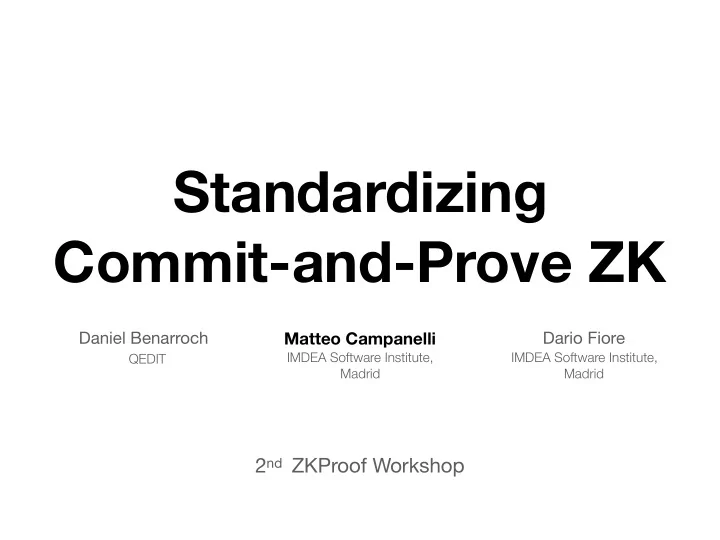

Standardizing Commit-and-Prove ZK Daniel Benarroch Matteo Campanelli Dario Fiore IMDEA Software Institute, IMDEA Software Institute, QEDIT Madrid Madrid 2 nd ZKProof Workshop
ZK P V . . . Look, V, I know u such that R(u) holds.
Commit-and-Prove (CP) ZK u P V . . . Look, V, I know u such that Commit-and-Prove ZKP: R(u) holds. And, by the way, A ZKP for the relation opens u R com (c, u) := R(u) AND c u opens
Motivation: Soundness + Integrity One example (from [WZCPS18]) training algorithm proof public ML model commit public commitment More: CP in several applications presented in this workshop Composition of proof systems [ C FQ19,Folklore]
My goal: throwing things at you re CP standards. Caveats on the focus: Applications Abstractions Non-Interactive case Implementation
Standardizing CP Why? What? How (much)?
Standardizing CP Why? What? How (much)?
Why Discussing a Standard for CP? • Extensive usage • → Typical reasons to standardize (maximize compatibility, etc.) • Idiosyncratic reasons • CP requires a particular type of interoperability NEXT: let’s give an example
Interoperability and CP opens R bank ( D ) AND D = Commit(D) opens R empl ( D ) AND D π bank π employer D π landlord Me my data opens R land ( D ) AND D Intuition: Di ff erent CPZK operate on the same representation (the commitment). This representation is part of the relation.
Standardizing CP Why? What? How (much)?
Step 0: One Single Notion for CPZK An arbitrary relation for CP: R com (ck, c, u) := R(u) AND “c opens to u w.r.t. ck” There exist two notions in literature; they treat ck differently* Notion (A) Notion (B) (ck output of KG) (ck input of KG) [Geppetto] [ C FQ19,Lipmaa16,~EG14] ck <- Com.Setup() . . . (ck, srs) <- ZKCP.KeyGen(R) srs <- ZKCP.KeyGen(ck, R) * NB : this distinction makes sense for systems with trusted setup. Recall KG syntax: srs <- ZK.KeyGen(R)
Comparing Notions May be the notion worth standardizing Notion (A) Notion (B) (ck output of KG) (ck input of KG) (ck, srs) <- ZKCP.KeyGen(R) srs <- ZKCP.KeyGen(ck, R) Commitment depends on Decouples commitment, R and on scheme. R and scheme. Enables nice Quite specific. applications for CP (e.g. commit-ahead-of-time, etc.) In the remainder of this presentation I will assume (B) as a CP notion to standardize
What to standardize? Plausibly , commitments. Why? 1. CPZK ~ ZK + Commitment R bank ( D ) AND D opens = Commit(D) opens R empl ( D ) AND D π bank π employer D π landlord Me my data opens R land ( D ) AND D 2. Commitments are the At least we may need to “interoperability bottleneck” agree on their syntax. and they are part of the relation.
A Commitment Syntax GOAL: A syntax for opens D As for CP , di ff erent notions of “opening” are possible. Let’s agree on one. A possible syntax: 𝖶𝗀𝗓𝖣𝗉𝗇 ( ck , c , D , o ) → b ∈ {0,1} “c opens to data D through opening o w.r.t. ck” Contrast this with (the more common) “Verification”-flavored (opening always carries D ) 𝖯𝗊𝖿𝗈 ( ck , c , o ) → D ∈ {0,1}* “Reconstruction”-flavored (need to be able to recompute D from (c,o))
A Definition for CP* [ C DQ19] R ( x , u , ω ) “free" Public Committed witness input witness Def . A CP-NIZK for relation R and commitment scheme Com is a NIZK for the relation R com ≔ ( ck, R ) s.t. R com ( x, c, u, o, ω ) ≔ “ R ( x, u, ω ) = 1 ⋀ VfyCom( ck, c, u, o ) = 1 ” CP syntax. KeyGen(ck, R) → srs = (ek, vk) Prove(ek, x, c, u, o, ω ) → 𝝆 Ver(vk, x, c, 𝝆 ) → 0/1 *credits to Dario Fiore for the slide.
Standardizing CP Why? What? How (much)?
CP and Relation Representation A Commit-and-prove relation shows separation of concerns: R bank ( D ) AND D opens Domain “Protocol” Logic Logic Q: Could CP be standardized at the level of relation representation?
CP and Relation Representation (cont.) Could compile automatically to R* that: define_rel( 1. shows opening of Y 2. applies domain logic name: myComAndProveRel, on domain input values (X,Y) vars:( X: Field, comY: Commitment(Field) ), Domain Logic constraints: VfyCom /* Domain logic R(X,Y) */ ) X Y C Y O Y Q: Could we do the same for other cryptographic constructs?
Not only Commit-and-Prove Could compile automatically to R* that: define_rel( 1. verifies signature on Y 2. applies domain logic name: mySigAndProveRel, on domain input values (X,Y) vars:( X: Field, sigY: Sign(Field) ), Domain Logic constraints: VfySig /* Domain logic R(X,Y) */ ) X Y S Y
Final Remarks/Qs • What abstraction(s) for CP? • def. should decouple commitment and relation (or should it?) • Current proposal: • modularity • enable “nice” properties (commit-ahead-of-time, etc.) • Standardizing commitments? Which syntax ? • Should we separate “domain” and “protocol” logic ? • Standardizing applications, implementation, etc…? Thanks!
Recommend
More recommend